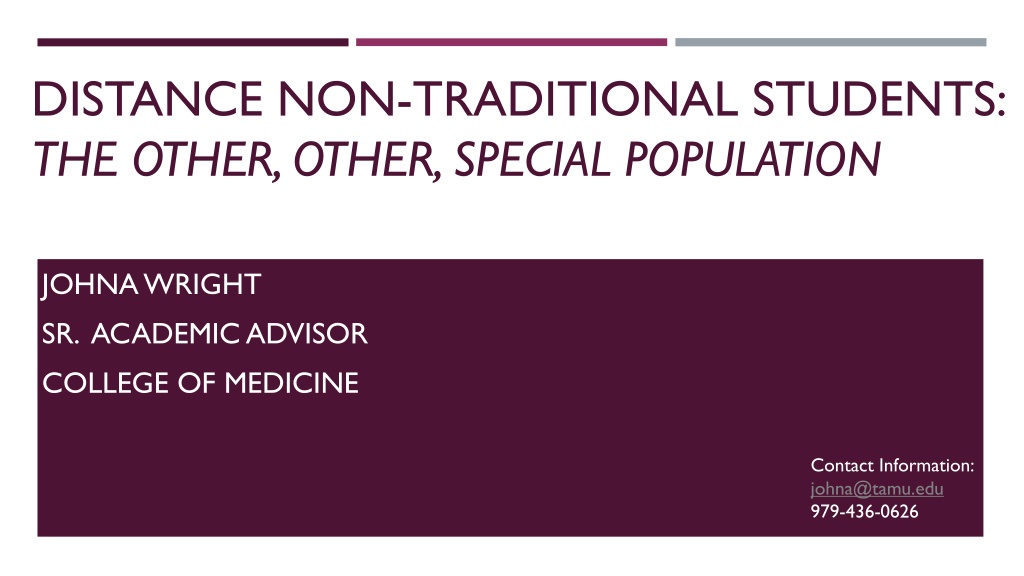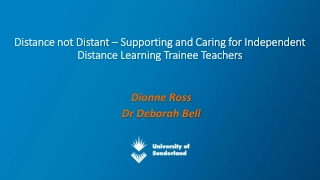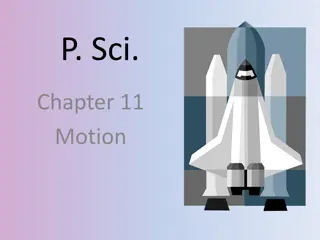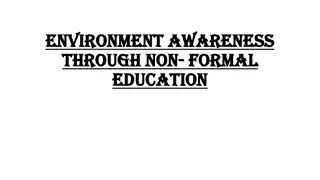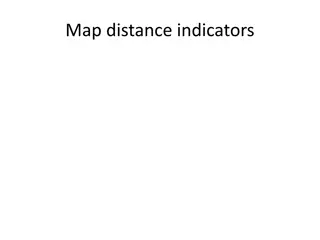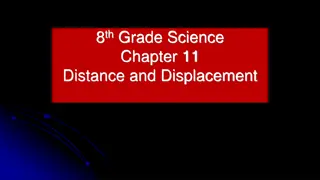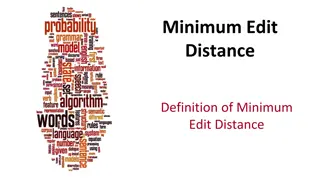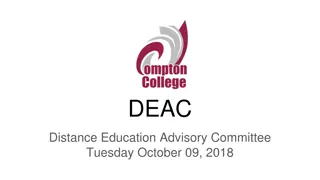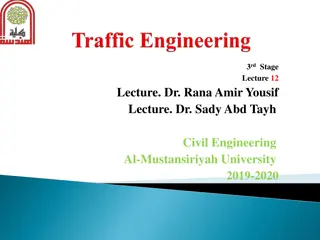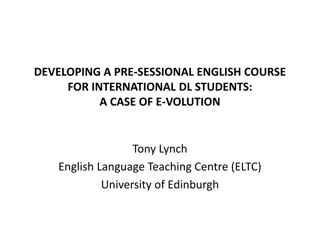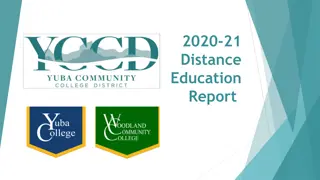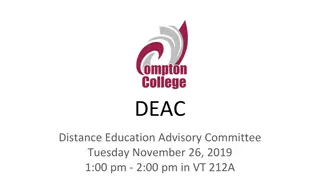Understanding Non-Traditional Students in Distance Education
This presentation explores the definition of non-traditional students in the context of distance education, outlining characteristics such as delayed enrollment, part-time attendance, full-time work, financial independence, dependents, single parenthood, and lack of a high school diploma. It also discusses the core competencies required for academic advisors working with this special student population and defines distance education as instruction delivered using technology to facilitate learning interactions between students and instructors.
Download Presentation

Please find below an Image/Link to download the presentation.
The content on the website is provided AS IS for your information and personal use only. It may not be sold, licensed, or shared on other websites without obtaining consent from the author. Download presentation by click this link. If you encounter any issues during the download, it is possible that the publisher has removed the file from their server.
E N D
Presentation Transcript
DISTANCE NON-TRADITIONAL STUDENTS: THE OTHER, OTHER, SPECIAL POPULATION JOHNA WRIGHT SR. ACADEMIC ADVISOR COLLEGE OF MEDICINE Contact Information: johna@tamu.edu 979-436-0626
AT THE END OF THIS PRESENTATION, YOU WILL BE ABLE TO: Recognize the definition of a non-traditional distance student Identify the advisor's role with this student population Explore strategies to successful advising with this student population
ACADEMIC ADVISING CORE COMPETENCY RELATION Core Competencies in the Relational component (skills academic advisors must demonstrate) include the ability to: R1 Articulate a personal philosophy of academic advising. R2 Create rapport and build academic advising relationships. R3 Communicate in an inclusive and respectful manner. R4 Plan and conduct successful advising interactions. R5 Promote student understanding of the logic and purpose of the curriculum. R6 Facilitate problem solving, decision-making, meaning-making, planning, and goal setting. R7 Engage in on-going assessment and development of the advising practice.
How do you define a non-traditional student?
NON-TRADITIONAL STUDENT DEFINED: Graduate online learners often display some of the characteristics of nontraditional students, such as items 2, 3, 4, and 5 below. Choy (2002) defined nontraditional students as those who have one or more of the following seven characteristics: 1. Delays enrollment (does not enter postsecondary education in the same calendar year that he or she completed high school); 2. Attends part time for at least part of the academic year; 3. Works full time (35 hours or more per week) while enrolled; 4. Is considered financially independent for purposes of determining eligibility for financial aid; 5. Has dependents other than a spouse (usually children, but sometimes others); 6. Is a single parent (either not married or married but separated and has dependents); or 7. Does not have a high school diploma (completed high school with a GED or other high school completion certificate or did not finish high school). (pp. 2-3) Choy, S. (2002). Findings from the condition of education 2002: Nontraditional undergraduates. Washington, DC: National Center for Education Statistics. Retrieved from http://nces.ed.gov/pubs2002/2002012.pdf
DISTANCE EDUCATION DEFINED: Education that uses one or more technologies to deliver instruction to students who are separated from the instructor and to support regular and substantive interaction between the students and the instructor synchronously or asynchronously. Technologies used for instruction may include the following: Internet; one-way and two-way transmissions through open broadcasts, closed circuit, cable, microwave, broadband lines, fiber optics, satellite or wireless communication devices; audio conferencing; and video cassette, DVDs, and CD-ROMs, if the cassette, DVDs, and CD-ROMs are used in a course in conjunction with the technologies listed above. U.S. Department of Education, National Center for Education Statistics, Integrated Postsecondary Education Data System (IPEDS), 2019-2020, Glossary results. Retrieved from https://surveys.nces.ed.gov/ipeds/VisGlossaryAll.aspx
Simplistic definition: Non-traditional distance student Really busy
Non-traditional distance student A student who is completing an educational program using technology and has other responsibilities other than their education.
What are some advising needs of non- traditional students? Think about their experiences!
NONTRADITIONAL STUDENT EXPERIENCES Motivations to Return Generation Gap A personal desire to complete what they started o Social alienation (no real peers) o Being a role model for their children o Discrimination (professors and other students) o Financial incentives o Academic priorities (group work logistics) o Academic Challenges Support System Acclimating to an academic regimen o Family o Balancing school with family life o Faculty (approachable/responsive) o Lack of support from the university o Bohl, A. J., Haak, B., & Shrestha, S. (2017). The Experiences of Nontraditional Students: A Qualitative Inquiry. Journal of Continuing Higher Education, 65(3), 166 174. Retrieved from http://search.ebscohost.com.srv-proxy1.library.tamu.edu/login.aspx?direct=true&db=eric&AN=EJ1158644&site=eds-live
IMPORTANT SERVICES FOR DISTANCE STUDENTS Advising Student development social, personal, and academic competencies (relationship impacts student persistence) o Academic Support Online academic support services (tutoring & library access) o Technical Support Access to support, user friendliness, and prior experience o Financial Aid Increase in subsidized loans and family contribution o Stevenson, T. ts1085@nova. ed. (2013). Online Student Persistence: What Matters is Outside the Classroom. Journal of Applied Learning Technology, 3(1), 21 25. Retrieved from http://search.ebscohost.com.srv-proxy2.library.tamu.edu/login.aspx?direct=true&db=eue&AN=90043854&site=eds-live
SUCCESSFUL ADVISING TECHNIQUES Non-traditional students Distance students Build Relationships Communication Web conferencing Communication strategies o Verbal and nonverbal cues o Mueller, D., and Meyer, A., (23 August 2017). Design a sustainable online advising option. Retrieved from: https://nacada.ksu.edu/Resources/Academic-Advising- Today/View-Articles/Design-a-Sustainable-Online-Advising-Option.aspx Flexible Advisement and Early Registration Options Schedule logistics o Communication - Email o Be available o Treat an email response as an advising session o Comprehensive o Fight the temptation to just give quick answers to quick questions o Timely o Prompt response saves you time in the long run Partners for Advocacy Collaborative support services o Specialized Resources Non-traditional handbook/guidebook, list of peer groups o Training and Professional Development Specific to student population needs o Fusch, D., (9 August 2013). Email advising: Doing it wrong, doing it right. Retrieved from: https://www.academicimpressions.com/blog/email-advising-doing- it-wrong-doing-it-right/ Sapps, L., and Williams, S., (12 November 2015). Best practices in advising nontraditional students. Retrieved from: https://nacada.ksu.edu/Resources/Academic-Advising-Today/View-Articles/Best-Practices-in-Advising- Non-traditional-Students.aspx
Think about some advising techniques you use?
